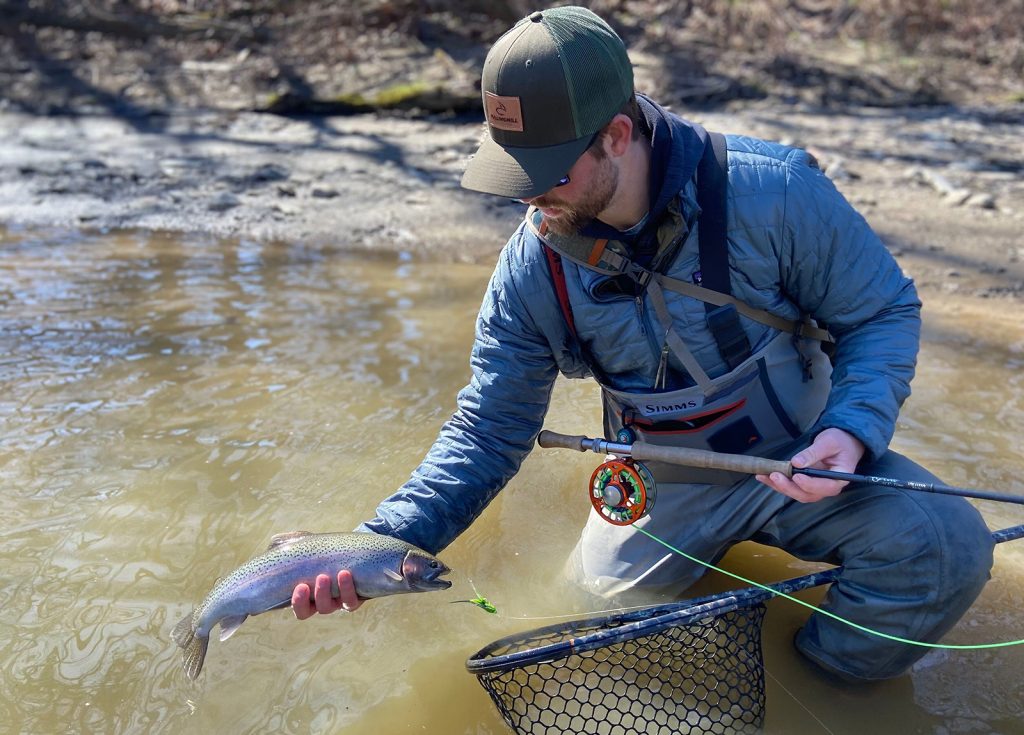
Today I’m pleased to present af blog text from Matt Redmond, who has kindly submitted this text about his awesome looking streamer flies and how he fished them. Matt Redmond is an avid fly angler and tier based in Northeast Ohio. He’s spent the last decade exploring the Great Lakes and their connecting waters with a special interest in steelhead, smallmouth bass, and freshwater drum.
Enjoy this!

Modern streamers take many forms, but most fit into one of a few categories – swim flies, jerk flies, and jig flies. Each type is designed with a certain action. Understanding how to elicit those actions, especially in current, is key to consistent success on the water.

Swim flies do exactly what you’d think – they swim, with tails that kick side-to-side or materials that undulate in current, mimicking a prey item. Large, dense heads are paired with slick, sparsely tied tail sections to create movement in the rear of the fly. Swim flies can be animated manually or by the current alone, making them versatile tools that can be stripped or swung through high-percentage zones to elicit strikes.

Unweighted swim flies like Game Changers, Bad Hair Days, and Zonkers are deadly when retrieved across current with short, violent strips and intermittent pauses on intermediate or sinking lines. They can also, however, be stripped upstream or downstream through soft water in eddies and along current breaks to great effect.

Jig flies are tied with front-loaded weight to drop nose-first toward the bottom on a slack line and rise when stripped. They can be fished mid-column or on the river bottom, and their weight and vertical action excel when retrieved upstream or downstream parallel to the current, where other flies struggle. Circus Peanuts, craw imitators, and Clouser Minnows are examples of popular jig flies.
Floating lines pair well with jig flies, as they help lift them with each strip. Short lifts of the rod tip or holding the tip a foot or so above the water can also aid in vertically displacing the fly when stripped. Swinging a craw imitation along the river bottom with small and intermittent pops is highly effective for trout and bass.

Jerk flies dart sideways and hover, showing profile to following predators – a well-established trigger. They are commonly tied unweighted with stiffer materials and elongated, arrow-shaped heads that facilitate sharp direction changes. A slack line is critical for their success, as constant tension inhibits their side-to-side movement.

Stepping or thrusting the rod toward the fly are options for adding slack. Thrusting the rod entails holding it out in front of us, pulling it toward our waders as we strip line, and thrusting it back out afterwards to deliver line to the fly. Twitching Jerk Changers or Jerk Jr.’s on intermediate lines above submerged wood or along current seams often proves irresistible to predators of many species.
Becoming familiar with the actions of our flies allows us to fish them with intention. Successful anglers can often visualize exactly what their flies are doing beneath the surface, ensuring they employ just the right movements to animate them in an appealing way. Swim, jig, and jerk flies are all excellent options as long as we can successfully bring them to life.

